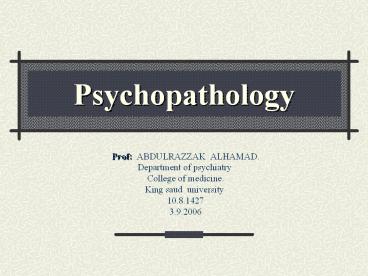Psychopathology - PowerPoint PPT Presentation
1 / 16
Title:
Psychopathology
Description:
Psychopathology Prof: ABDULRAZZAK ALHAMAD. Department of psychiatry College of medicine. King saud university 10.8.1427 3.9.2006 Introduction: Psyche == Mind ... – PowerPoint PPT presentation
Number of Views:175
Avg rating:3.0/5.0
Title: Psychopathology
1
Psychopathology
- Prof ABDULRAZZAK ALHAMAD.
- Department of psychiatry
- College of medicine.
- King saud university
- 10.8.1427
- 3.9.2006
2
Introduction
- Psyche Mind Pathology
disease - Psychopathology
- scientific study of abnormal states of mind.
- A) Descriptive (phenomenological)
Psychopathology. - Objective description of abnormal states of mind
as experienced by the patient or observed in his
behavior. - Descriptive Psychopathology Epidemiology
Scientific basis for clinical psychiatry. - B) Dynamic Psychopathology
- Through unconscious mental mechanisms Causes of
abnormal states of mind
3
A. Descriptive Psychopathology
- In psychiatric symptoms look for
- 1) Intensity, persistence and syndrome grouping.
- 2 ) Pirmary or secondary (temporal) time
course. - 3) Form and content
4
- 1) Disorders of Appearance
- Body build ,state of health, self- care, dress.
- 2) Disorders of Behavior
- a. Activity slow retardation), excitement,
agitation. - b. Abnormal movements
- 1) Adaptive movement gestures, tearfulness,
laughing. - Mannerisms idiosyncratic elaboration of normal
behaviors. - 2) Non- adaptive movements
- Tics involuntary , reprtitive, group of
muscles, under control. - Tremors resting familial, intentional.
- Chorea involuntary, sudden,jerky, random, semi
purposeful, not under control. - Stereotype uniformal, non- goal directed.
- Dyskinesia uncontrolled,random,non-goaldircted.
- Echopraxia and echolalia repetition of actions
of others and of speech of others respectively.
5
- b.Abnormal movements contd.
- 3)Catatonic behaviors
- Negativism resistance to suggestion and
tending to do the opposite. - stupor mutism , akinesia and non-
responsiveness to environment, in full
consciousness. - Posture Disorders waxy flexibility, resistance
and preserved posture.
6
3)Disorders of Perception
- 1. Intensity change hyperacusis, hypoacusis.
- 2. Size change micropsia, macropsia.
- 3. Images.
- 4. Illusion false perception of a real
stimulus. - 5. Hallucinations (True) preception without
stimulus .
7
Criteria
- Pseudo hallucinations
- 1. Not clear as real perception.
- 2. Controllable.
- 3. Within subjective space.
- 4. Preceired inside body.
- 5. Intact insight.
- True Hallucinations
- 1.Qualities of real perception.
- 2.Uncontrollable.
- 3.Perceived as outside subjective space.
- 4.Perceived in sensory organs e.g. eye,ear,etc.
- 5. Lost insight.
8
Disorders of perception contd
- Types elementary fragment of voices.
- Complex organized voices.
- Modalities auditory, visual , olfactory,
tactile, gustatory and somatic (proprioceptive).
9
4) Disorders of Thinking
- a. Disorders of content
- 1) Delusions fixed, unshakable, false idea and
out of cultural background of the patient. - - Primary autochthonous ideas.
- - Secondary to other experiences, affect or
perception. - Types paranoid, persecutory, grandiose,
delusions of reference, guilt, nihilistic,hypochon
driacal, etc. - 2) Passivity Phenomena
- - Thought insetion, withdrawal, broadcasting
- - Made feel, think, act.
10
Disorders of thinking contd
- 3) Overvalued Ideas
- shakabale, preoccupation, mostly false.
- 4) Ideas of references
- shakable, non- psychotic, if unshakable they are
delusions of reference ( psychotic). - b. Disorders of form and stream of speech
- - Slow thinking , racing thoughts, thought
block. - - Flight of ideas, poverty of thoughts.
- - Loosening of association, word salad.
- - Talkativeness, pressure of speech.
11
5) Disorders of affect
- - Depression, - Euphoria, - Apathy, -
blunted,-flat. - - Preplexity,- Fear, - Anxiety.
- Look for
- Quality, appropriateness or congruity, constancy.
12
6) Intellectual disorders
- a. Consciousness - Clouding. -
Confusion. - b.Attention and concentration - Focus and
comprehend. - c.Orientation
- - Time (hour, week,
year). - - Person (identity of
self and others) - - Place.
- d.Memory
- - Recent (short term), remote (long term).
- - Déjà vu sense of familiarity.
- - Jamias vu sense of unfamiliarity.
- - Confabulation filing memory gaps.
- e- Dissociation
- - Fugue wandering, reduced
consciousness, patchy impaired recall of events. - - Amnesia.
13
7) Other Experiences
- a) Obsessional Thoughts , feelings , impulses,
doubts - recurrent, compulsive, silly and irresistible,
patients own thoughts. - b. Compulsions Acts and behaviors which are
recurrent, compulsive, silly and irresistible. - c. Disorders of self-awareness
- - Depersonalization feeling of oneself unreal or
changed. - - Derealization feeling of unreal environment (
dream- like state), things around have changed.
14
8) Disorders of insight
- - There is a change.
- - This change is abnormal.
- - This abnormality is psychological.
- - This abnormality needs treatment.
15
B. Dynamic Psychopathology
- - Mental mechanism unconscious, may by normal or
pathological. - - Examples
- a. Rationalization The commonest, provides
alternative explanation
for instinctual motives and
drives. - b. Repression leads to inability to remember
unpleasant wishes or
impulses (i.e. hysterical
dissociation). - c. Reaction formation an unacceptable impulse
is transferred into its
opposite.Common in obsessional neurosis. - d. Denial may refer to the effect associated
with an idea or event or
may include the whole episode.
16
Dynamic psychopathology contd
- e. Projection
- Ones own feelings and wishes are attributed to
another person. - Common in normal but fundamental in paranoid
psychosis. - f. Regression
- a return to an earlier state of psychological
development in order to avoid tension and
conflict of the present. Common in normal under
stress, as well as in pathological states. - g. Sublimation
- conversion of energy from one unaccepted
activity to socially acceptable one, mostly it is
normal.































